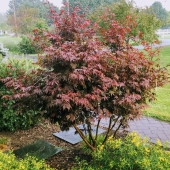


Collection of 14 Permaculture/Homesteading Cheat-Sheets, Worksheets, and Guides
will be released to subscribers in:
soon!



 1
1





 2
2




Works at a residential alternative high school in the Himalayas SECMOL.org . "Back home" is Cape Cod, E Coast USA.

 2
2




 1
1




Invasive plants are Earth's way of insisting we notice her medicines. Stephen Herrod Buhner
Everyone learns what works by learning what doesn't work. Stephen Herrod Buhner
 2
2




pax amor et lepos in iocando
 2
2




 1
1




Christopher Weeks wrote:So, I don't really know anything about allergies -- I have several relatively mild chemical sensitivities to VOCs in perfume and coffee, but I'm not actually allergic to anything and haven't been in 50+ years since I shed my childhood egg allergy. But I'd approach beans from a taxonomy standpoint if I were in your shoes and try to determine what classes and categories I had issues with.
Common beans (mostly what Americans mean by "beans") are Phaseolus vulgaris. These are kidney, navy, pinto, black, etc plus most green or wax beans. I'd expect them to have most of the same proteins, with relatively minor differences in proportion from seed to seed. There might be vast differences between dry beans and green beans, though due to maturity.
Runner beans (which look very much like common beans, but are usually bigger) are Phaseolus coccineus. I have no idea how different the protein structure is and what the means for triggering your allergies -- they feel pretty similar to common beans, but it's a different species of the same genus so there might be differences. Tepary beans (Phaseolus acutifolius) are another Phaseolus species, but I don't know much about them. Lima beans are P lunatus.
Fava beans are Vicia faba and pretty different in appearance and texture. It wouldn't surprise me if their protein profile was different, but I don't really know.
Adzuki beans (Vigna angularis), mung beans (Vigna radiata), and cowpeas (Vigna unguiculata) are different species of another family.
Red gram/pigeon peas are Cajanus cajan, are from yet another family.
Soy (Glycine max) is another bean too.
Haha...I decided to poke around and see what I was forgetting, but there's no reason I should just rewrite stuff when I can link you to this. There are a lot of beans!
Anyway, I'd try getting as much variety as possible -- especially from different genera, to shift the profile that your body is seeing and responding to.
 1
1




Melissa Ferrin wrote:... she got sicker with every exposure. I think it's probably best if you just avoid legumes.
But if you wanted to try something in the legume family that is not "bean" how about mesquite? you can order mesquite flour online.




Casie Becker wrote:
Jenny, does your allergy respond to fermented as well as fresh foods? My only food allergy is tomatoes. If I stick to an ultra low carb diet (went keto 3 years ago) they don't noticeably bother me. When I go off diet I respond much more to cooked tomatoes. I don't think beans and keto mix well, or I'd suggest trying that. But maybe a different preparation style would break down whatever your body is responding to.




Rebecca Norman wrote:The fava bean genus is different from al those you listed, but they cause weird intolerance issues in some people already so I'm not sure that would be a good direction for you.
 2
2





|
chirp chirp chirp tiny ad chirp chirp
Freaky Cheap Heat - 2 hour movie - HD streaming
https://permies.com/wiki/238453/Freaky-Cheap-Heat-hour-movie
|




